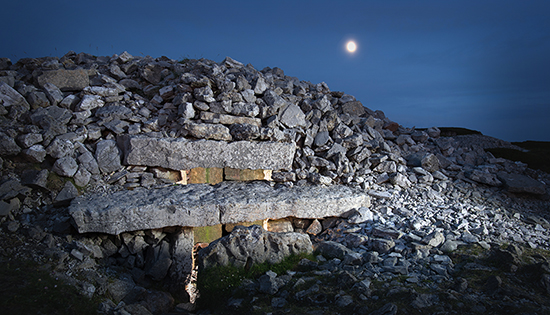
A short, steep climb from the car park at Kilmashogue Forestry, along a track through the mature plantation, leads to an atmospheric clearing where the approximately four thousand year old ruins of a rather fine example of a bronze age wedge tomb lies. On an unexpectedly fine Saturday evening, it makes for an ideal spot for a quick visit with the family. It has all the charm and quiet of a fairytale forest, with pine cones to collect and a moss covered ‘fairy castle’ to explore!

The ruins lie in a crowded and confused jumble. This apparently is not the legacy of the overly enthusiastic trend for ‘excavation by demolition’ of the early antiquarians in centuries past, or the work of the modern vandals who have reduced the information signs and protection notices to skeletal traces. It appears that the tomb was at least partly dismantled when three bronze age burials kists were inserted into the wreck, using some of the structural stones from the original megalith.
No doubt much of the cairn has also been appropriated to construct the low and overgrown field walls that snake between the trees. Some stretches of a kerb can also still be seen within the bank and ditch that encircles the tomb.

The 4m long chamber faces west and may have been deliberately orientated directly towards Montpelier Hill and its flattened passage tombs. A stumpy sill-stone segregates the inner and outer galleries, the unusual triple-walling is another notable feature that keeps a mega-rack intrigued while the rubble and leaf-filled pockets are an ideal assault course for toddlers keen on honing those elusive superpowers.

Excavations were carried out in the 1950s, shortly after it was first recognised as a megalithic tomb. The excavator, H. E. Kilbride-Jones, was assisted for a period of two weeks by Rúaidhrí de Valera and Seán Ó Nualláin of the Royal Irish Academy. Within the cairn they discovered three kists, still concealing their burial urns and cremations. Two had been inserted behind the main chamber of the tomb while another was discovered in the portico. One of the three is easy to spot, its slab-like capstone having been hauled back revealing the neat, rectangular chamber below. It is roughly 1m square in size and partly filled with debris.

This is a really nice example of the type, and a definite hit with the kids. Thankfully there were no signs of the bottles, broken glass and camp fires often found around and within the tomb itself. With proper signage and information this would be a wonderful attraction for hikers and families alike, one that is really hard to do proper justice with pictures alone.
More info, directions and pictures can be found at Megalithomania, Megalithic Ireland and Megalithic Monuments of Ireland.
Recommended reading:
Monumental about Prehistoric Dublin (Fourwinds, Tom)
Irish Megalithic Tombs (Shee-Twohig, Elizabeth)
Temples of Stone (Jones, Carleton)

